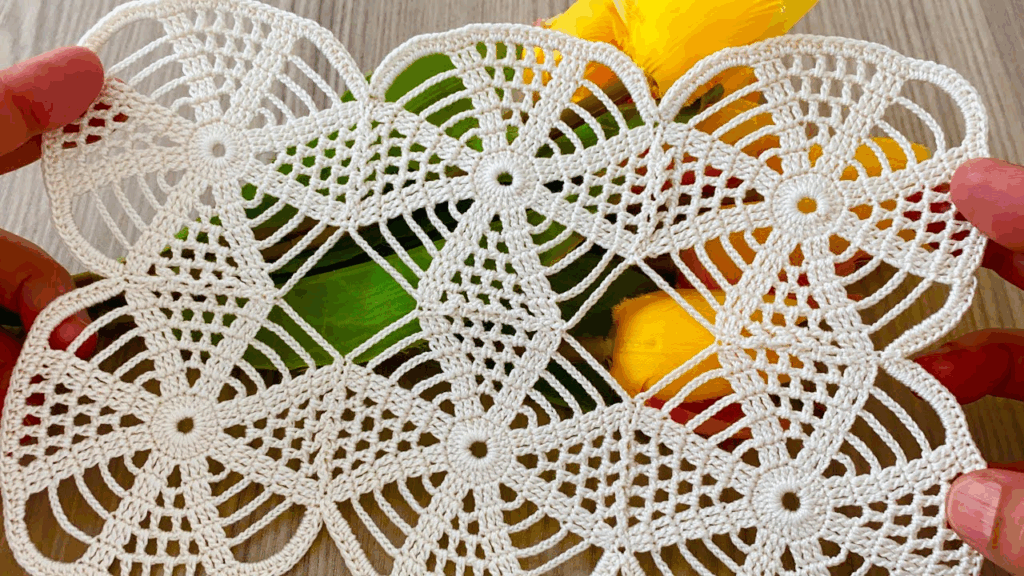That is a request for one of the most beautiful and intricate styles of crochet! Irish Lace (or Irish Crochet) and Vintage Motif Crochet are distinguished by their use of highly dimensional motifs, fine thread, dense padding cord work, and joining them together with delicate, irregular mesh (the filet or netting).
Recreating this style requires focusing on three core components.
Here is a detailed tutorial focusing on creating the essential elements of an Irish or Vintage-style motif.

⚜️ Irish & Vintage Motif Crochet Tutorial
We will focus on creating a Raised Rose Motif (the dimensional element) and the simple Picot Mesh (the joining element).
Materials You’ll Need
- Thread: Size 20 or 30 Mercerized Cotton Thread (finer thread gives a more authentic, delicate look).
- Crochet Hook: A very small steel hook appropriate for your thread (e.g., 1.0 mm to 1.5 mm).
- Scissors, Tapestry Needle.
Key Crochet Terms
| Abbreviation | Stitch Name | Purpose in this Style |
| ch | Chain | Creates the connecting mesh |
| sl st | Slip Stitch | Joining and shaping |
| sc | Single Crochet | Used for dense edges and mesh anchors |
| dc | Double Crochet | Used in the motif body |
| tr | Treble Crochet | Used for tall, dimensional petals |
| Picot | Ch 3, sl st into the first ch | Essential decorative element for mesh |
| Shell | (sc, hdc, dc, tr, dc, hdc, sc) | A simple petal shape |
Part 1: The Dimensional Raised Rose Motif
This flower is built in layers, often anchored with a dense center.
Round 1: Foundation (Center)
- Start: Make a Magic Ring. ch 1. Work 12 sc into the ring.
- Finish: Pull the tail tight. Join with a sl st to the first sc. (12 sts).

Round 2: Inner Petals (Base Layer)
We use back loop only (BLO) to leave the front loop available for a later stem or attachment.
- ch 1. Work sc in the BLO of the same st.
- Petal Loop: ch 4. Skip 1 st.
- Repeat: [sc in the BLO of the next st, ch 4, skip 1 st] 5 more times. (6 ch-4 loops).
- Finish: Join with a sl st to the first sc.
Round 3: Outer Petals (Dimensional Layer)
We work large, tall shells into the ch-4 loops to create the dimensional curve.
- sl st into the first ch-4 loop.
- First Petal: Work [sc, hdc, 4 dc, hdc, sc] into the loop.
- Repeat: Work [Shell (sc, hdc, 4 dc, hdc, sc) into the next ch-4 loop] 5 more times. (6 finished dimensional petals).
- Finish: Join with a sl st to the base of the first petal. Fasten off.

Part 2: The Connecting Picot Mesh
After creating several motifs (like the rose above, and perhaps some leaves or shamrocks), you need the connecting mesh. This is worked between the finished motifs.
1. Anchoring the Motifs
Lay your finished motifs (e.g., three roses) on a flat surface in the arrangement you want.
- Anchor Edge: Rejoin the thread to a finished motif at the edge of a petal. Work a dense round of sc around the entire perimeter of the motif, placing sc stitches evenly. Picots can be placed along this edge for decoration (e.g., sc in 3 sts, Picot, sc in 3 sts, Picot, repeat).

2. Creating the Mesh (Working between Motifs)
The traditional Irish mesh uses varying lengths of chain and sc stitches to create an irregular, strong netting.
- Start: Join thread to the edge of Motif A with an sc.
- Chain: ch 5.
- Anchor 1: Work sc into the edge of Motif B.
- Chain: ch 7.
- Anchor 2: Work sc into the edge of Motif C.
- Building the Net: Now, you begin working off the chain loops themselves to fill the space.
- ch 5. Work sc into the middle stitch of the previous ch-7 loop.
- ch 3, Picot, ch 3. Work sc into the next ch-5 loop.
- ch 9. Skip the anchor sc and anchor into the next petal edge.
- Continue: Continue adding chain loops of varying lengths (ch 3 to ch 9), anchored by sc stitches, until the space between all the motifs is completely filled with a dense, interconnected net.
Key Style Tip for Beginners: Do not try to make the mesh perfectly uniform. The beauty of Irish lace is the intentional irregularity of the mesh, which allows the dimensional motifs to stand out dramatically against the airy background.

3. Final Blocking
Irish lace absolutely must be blocked. Pin the entire finished piece (motifs and mesh) very firmly to a mat, ensuring the mesh is stretched taut. Allow it to dry completely—this is what locks the delicate structure into place.
Video tutorial:



